Transit: Art in Off-Peak
By gamer_152 3 Comments
Note: The following article contains major spoilers for Off-Peak.
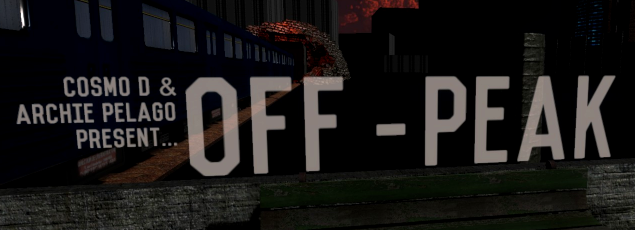
Video games are full of painstakingly painted and sculpted visual art that we never truly look at. There are so many instances where we get these gorgeous, detailed sprites or 3D models served to us that we can't zoom in on, that artists shove into the background, or that we blow right past. Cosmo D's Off-Peak is a game that gives us the motivation and the accommodations to stop and stare a little longer.
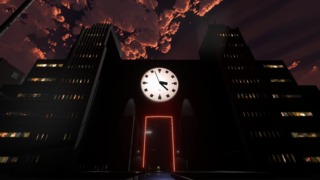
They say you should start as you mean to go on, but when a piece of media submits a misleading intro, that can allow it to rig a pleasant surprise. Off-Peak opens on a secluded pier, where a shady musician brings the good news that he's secured us a ticket for the nearby train station. But wouldn't you know it, that ticket got torn up, and its pieces scattered around the environment. As you approach the doors of the transit hub, the building towers over you. Red light bleeds out from behind its edifice, and a clock stares you down, ominously speeding through hours in the space of minutes. The building's walls reflect no light; they are as black as soot. In the forecourt, angry protestors make their voices heard while pale enforcers observe them from behind fashionable sunglasses. Then the gates groan open, and either side of you, there are two rich, minimalist, cool-as-fuck prints. You walk forward onto a balcony overlooking a noisy atrium of audacious and surreal exhibits, and it turns out this isn't a train station. This is a gallery.
Summarising what's in that gallery is impractical because it stretches across numerous forms, decades, and styles. There are Polish circus posters that forgo shading and use thick lines and high saturation to create cartoonish, blobby patterns. There's greyscale graffiti that uses precise edges and detached depictions of subjects to capture disaffection and pain. There's a tesselated profile of a man dressed as a cowboy with text above and below, realising the mythical Hollywood figure of the western gunslinger. There is a stained glass window tastefully depicting a peacock. There are plastic steer skulls illuminated from the inside so brightly that all their features are obscured. There is silver-age comic art of Doctor Doom, complete with Ben Day dots. And this is only scratching the surface. The only trait that most of Off-Peak's pieces have in common is being digestible and modernist. To find all the ticket scraps, you wander from the main hall into various side zones like the platforms, the abandoned subway, and the board game cafe. Off-Peak is a living example of how we get more viewing time with assets when the level routes us back to where we've been. These return trips prompt us to reexamine.
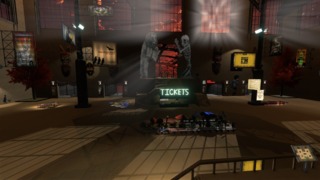
Games don't always afford you the best viewing angle on paintings, prints, sculptures, etc., but Off-Peak lubricates the viewing process by making a lot of its visuals enormous. Large props are not rare in the medium: Objects typically appear smaller on screen than they do in real life, so if you want the player to get a good look at them, it helps to scale them up. That's especially true if they're off in the distance or the player might be distracted from them or only glimpse them briefly. AAA games often go big with setpieces to draw your eye to them, highlighting entities that have a mechanical function or that serve as a landmark to help you navigate. And when the player character is optimised for covering a lot of distance quickly, designers need to super-size the world to compensate. Embiggening objects also has aesthetic and semantic implications: it makes them feel impressive and important, as demonstrated by the hulking golems of Shadow of the Colossus or the boundless map of Red Dead Redemption 2.
Like these other games, Off-Peak gives its art some serious stature for the purposes of visibility and grandiosity. In that regard, it's typical in how it uses size. What's atypical about it is how many large objects it packs into a tiny map and how many you can invade the personal space of, soaking in every metaphorical brushstroke. Then you have all these models and textures hanging over you or extending far above your eyeline. You don't look up a lot in first-person games; it would typically distract from the action, but there isn't action in Off-Peak, so it can keep you craning your neck in awe at banners and street art perched up where pigeons soar. Using the whole Y axis also allows the developer to fit more eye candy into less space.
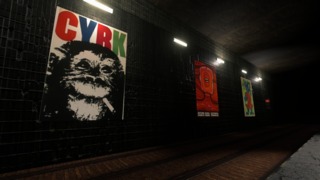
There's further a fine reminder in here that some types of environments get more accessible when you situate them in a video game. In a computer game, many disabled people can glide through spaces that would fight them every step of the way in the real world, and even able-bodied individuals can explore them without exhaustion. Architects design spaces with bodies in mind, so freeing occupants from a physical form changes the architecture. If the player has the legs of a robot Usain Bolt, the architect can sketch up long corridors and steep stairs without fear that a visitor's muscles will give out on them. Free reign of a space then gives us free reign to what it houses.
There's one more catalyst that the game drops into the beaker in hopes of getting you to hone in on the art. This time, something invisible. We're encouraged to engage with Off-Peak's attractions via the context of an exhibition. I described earlier our tendency to blaze past visuals without taking them in. That isn't just something we do in video games; it's how we treat most sights. It's not often someone traces every wisp of the clouds in the sky or pores over all the stitches of a piece of furniture in their day. But people will drink in every square inch of a painting in a gallery. They'll look at the colour, the shape, the lighting, the shading, and the dynamics between all the elements. And in my experience, even when someone doesn't understand or like a piece of art, in a museum, they typically make an effort to respect it and meet it on its own terms. Off-Peak is encouraging you to do the same with the items in its collection. It's also bucking conventional wisdom about what constitutes art. People make pictures on and out of a lot of things, but there's always been a snobbish protectiveness about what receives the respect of the museum exhibition. Art made on canvas or plaster or out of marble gets it, but art made on beer labels, game boards, or album covers generally doesn't. Off-Peak's museum isn't that arrogant; its philosophy is that if it looks cool, it's worth displaying.
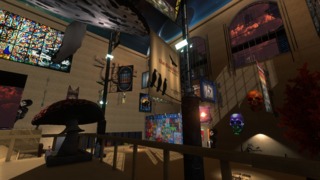
The round decals on Off-Peak's walls and the banners hanging over its main hall are mostly stickers from drinks bottles. It also includes a larger-than-life aquarium, books of cello music, and even food like cookies and pizza. If it sounds far-fetched to think that the game wants you to associate the food with the posters and paintings, there's a ramen cook who tells you bluntly that his noodles are art. And he is too. The characters' status as works in the museum is well demonstrated by a couple in the tower. Next to a macabre, flood-lit painting of a skull and spine, two men kiss. One of them holds a shiny cherry-coloured skull behind his back. He's being intimate with this man, but at the same time, guarding something morbid or internal from him. For another example, see the giant sitting at a piano with his shoes up on the keys. He is an absurd performance piece. The short physical distance Off-Peak establishes between its "high art", "low art", and what is traditionally considered non-art suggests a short aesthetic distance.
But is any of this any good? I'm talking about the noble goals of curating a video game art gallery, but if it's a gallery, shouldn't we leave it with some sense of whether the pictures and models are enjoyable to look at and whether they make incisive statements? Trying to review the work on display in Off-Peak reminds me of how little we close-read the art of games, and how rarely we describe video game graphics with the same critical basics we use for drawings or frames of films. For all the advancement in the last decade of games analysis, it's still a razor-thin slice of the critical pie that is turning to games with an eye for composition, framing, or the use of light and shadow in anything more than a technical sense. Not that I'm exactly a John Ruskin.
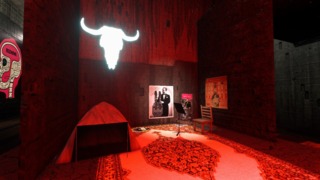
Nonetheless, there are too many items with too much diversity in Off-Peak to summarise. Most reviews of exhibitions are reliant on museums displaying works from only a few or one media, usually held together by some adhesive artist, period, or movement. But Off-Peak's curation endeavours to abolish that categorisation. Its theme is that it has no theme. The closest I can get to wrapping its assets up in a neat little bow is that it's got a caffeinated, thickly-layered soundtrack provided by Archie Pelago that gratefully snaps up cues from jungle music and jazz. It enmeshes it with visual art that has a big personality and that often skins, recolours, and mangles familiar forms to original ends. The game's sound and textures all have the refreshing, hip tang of the inner city. They make me feel like I'm somewhere thrumming with busy footsteps and bursting with new ideas.
If you were being harsh, you could say that the art has the hallmarks of local council-comissioned graffiti or coffee shop wall hangings. Most of the creations do not challenge anyone who has a slight stomach for modern art or leave an imprint of a particular worldview or experiences. I'm pretty smitten with the face Off-Peak wears, but there are some who would say your eyes swoop too easily over the pictures, that it all goes down too smoothly, and it's worth considering that perspective too.
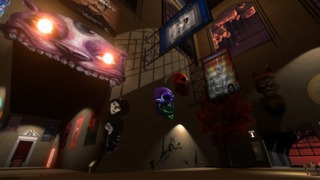
The most obvious aesthetic criticism of Off-Peak overall would be that it's unfocused. That unbound from theme or creative prescriptions, it was always doomed to lack an artistic throughline. That there are so many artworks singing their own unique part that they're all drowning each other out, never able to harmonise. And I'm not going to tell you that assessment is wrong, but there is another vantage point from which to view the game. The background of co-developer Cosmo D is well-documented: he is a lifelong musician trained as a cellist and active in New York City's music scene. Therefore, Off-Peak's setting reads as an autobiographical environment.
The besuited man shopping for beginner cello music, the stand of jazzy albums, the playful improvisations on MTA signage, and the instrumentalist's nook on the subway platform are all refractions of Cosmo's life. It's not hard to imagine that tabletop sessions at cafes or steaming ramen bowls could fit into it too. Where Unpacking is a game that shows how a person furnishes a place to depict who they are, Off-Peak depicts who a person is by making them the place itself. And people don't live every moment of their life in the same style, mood, or medium. We might curate a brand for social media, or an artist might favour a filter of expression, but inside, we are all a messy overlap of drink bottles, book covers, subway signs, and local delicacies. If Off-Peak resists holistic analysis, it's because we all do. Thanks for reading.